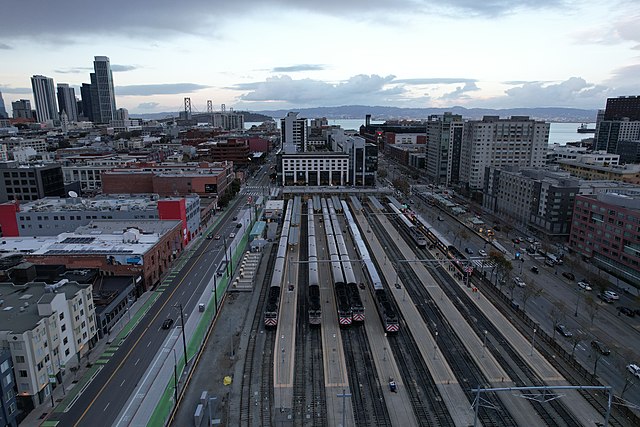Caltrains announced last week that the cost of the last 1.3 miles of its commuter-rail line into San Francisco would cost $6.7 billion, a 34-percent increase from an estimate made in 2015. The only rail construction that has cost more per mile is New York City’s Eastside Access project.
The planners of San Francisco’s Transbay Transit Center had taxpayer money to burn so they put a huge city park on top of the station. Photo by Fullmetal2887.
The city is constructing this based on the ridiculous notion that all rail lines should connect together. Currently, the Caltrain commuter trains from San Jose terminate near the site of the historic Southern Pacific train station in San Francisco, while the BART line from Oakland goes to what was once called the Transbay Terminal but now (after a $2 billion upgrade) is called the Salesforce Transit Center after the cloud computing company that paid $110 million for naming rights.
Update: I am reminded that BART doesn’t go to the Transbay Terminal, which I knew but had forgotten because it has been so long since I’ve visited there. The Transbay Terminal was originally built for Key line streetcars from Oakland, but recently has served only buses. The city spent $2 billion rebuilding it in anticipation of the high-speed rail, so now it has to spend $6.7 billion for a tunnel for the high-speed trains to go through. Sorry for the error.
According to Google maps, the Caltrain station is a 26-minute, 1.2-mile walk or a 17-minute streetcar ride from the Transbay Transit Center, which makes it obvious to transit planners that it is worth $6.7 billion to connect the two by an underground rail line. Photo by InvadingInvader.
San Francisco’s N streetcar line, which operates about every 10 minutes, comes close to connecting the two, but it takes 10 minutes and requires seven minutes of walking. The planned underground Caltrain line would probably take five minutes considering the tight curves it would have to make to avoid building substructures.
The transit center’s director says that spending the $6.7 billion will allow people to “take a bus from any of the Bay Area counties into downtown and hop on Caltrain or high-speed rail and be destined statewide.” But they can already do that; they would just have to take a different bus to get to the Caltrains station than the bus they would need to take to the Transbay Terminal. Taxpayers could save billions of dollars if the agencies simply provided a free shuttle bus every 15 minutes between the two terminals (which would take about 7 minutes), but the agencies don’t see the point because they are spending other people’s money.
The ultimate goal is to have California’s mythical high-speed trains, which are supposed to use or parallel the Caltrain line, reach the transit center. Of course, it’s a big “if” whether the high-speed rail line will ever actually reach the Bay Area, but even if it does, there is no particular reason why it has to go all the way to the Transbay Terminal instead of the current Caltrains station.
Maybe California can persuade FTX to buy the naming rights for the 1.3-mile connection between the two terminals. That’s about as viable as the high-speed rail project. In any case, this is one more example of the fact that (except for streetcars) there is no rail project whose price is so high that transit advocates would decide it isn’t worth building.










With the way electricity prices have gone in Cali, curious how they’ll be able to afford to run many of these trains.